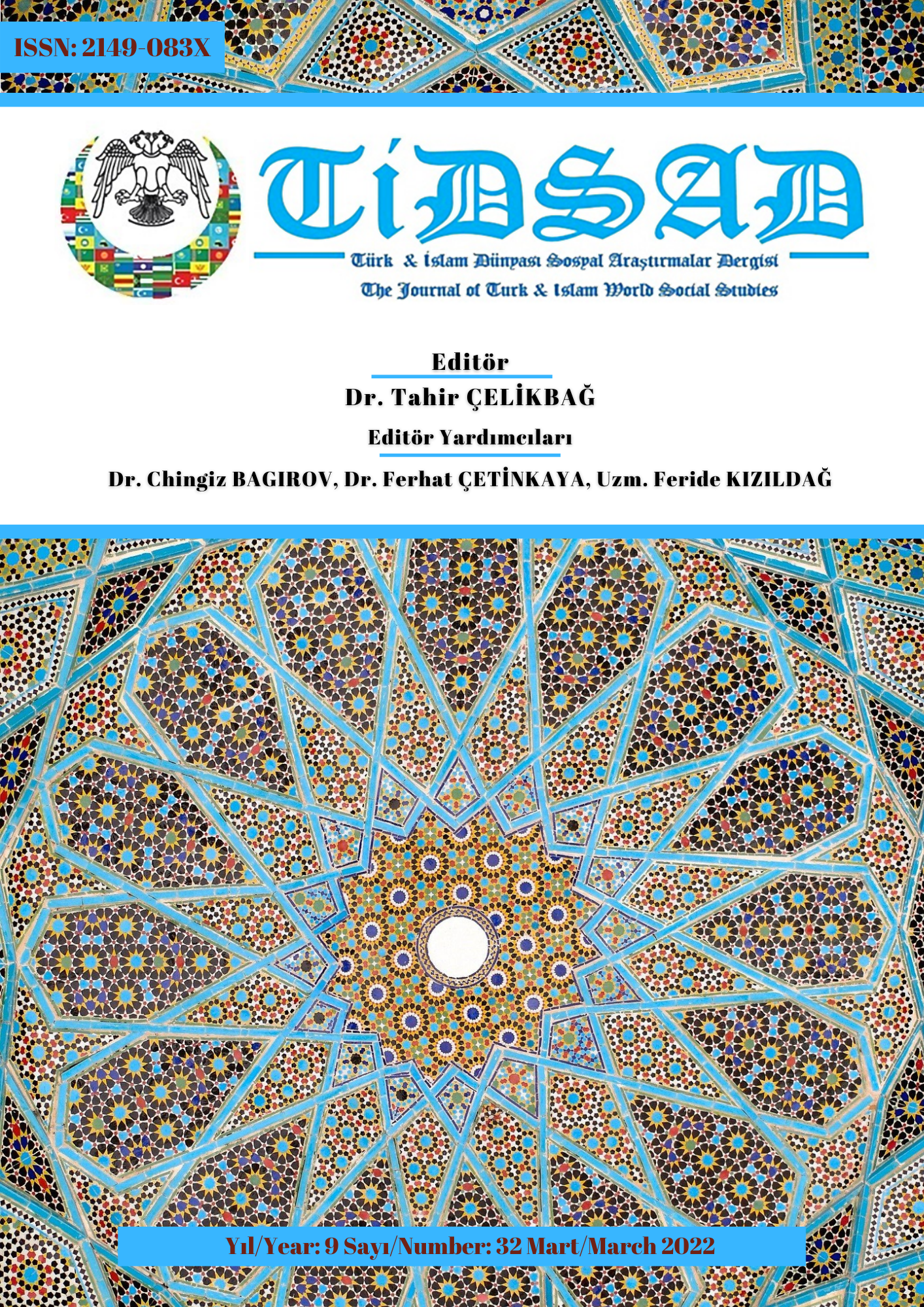Author :
Abstract
Doğa, mağara döneminden günümüze kadar sanatın ve sanatçıların daima ilham kaynağı olmuştur. Teknolojinin gelişmesi, bilimin katkıları, politika ve sanayi devriminin sonucunda oluşan çevre tahribatı, toplumsal yapılarda meydana gelen farklılık vb. sebeplerden ötürü sanatçıların doğaya olan bakış açıları değişime uğramıştır. Bazı sanatçılar eserlerinde bu farklılıkları gösterme çabasına girmiştir. Günümüzde sanat eğitimi yoluyla sanatçıların çevredeki bu oluşumlara dikkat çekmek adına yaptıkları çalışmalar bulunmaktadır. Bu araştırmada, çevre sorunlarından olan betonlaşmayı eserlerinde kullanan sanatçılardan Joseph Beuys, Soazic Guezennec ve Murat Akagündüz’ün eserlerine odaklanılmıştır. Ayrıca ilköğretim 3. ve 4. Sınıf öğrencilerinin dikkatini bu konulara çekmek ve onlarda bir farkındalık yaratarak, sorgulama becerisini kazandırmak adına bir ders planı önerisi sunulmaktadır. Araştırmada betimsel yöntem kullanılmış ve çalışma tarama modeli ile tamamlanmıştır. Araştırma bulguları da “çevre sorunları ve sanat eğitimi” ve “sanat yoluyla çevre eğitimi” olmak üzere iki ana başlıktan oluşmuştur.
Keywords
Abstract
Nature has always been a source of inspiration for art and artists from the cave period to the present. The development of technology, the contributions of science, the environmental destruction as a result of politics and the industrial revolution, the difference in social structures, etc. For these reasons, the perspectives of artists towards nature have also changed. Some artists have tried to show these differences in their works. Today, there are works by artists to draw attention to these formations in the environment through art education. In this research, the works of artists Joseph Beuys, Soazic Guezennec and Murat Akagündüz, who use concretization, which is an environmental problem, in their works, are focused on. In addition, a lesson plan proposal is presented in order to attract the attention of 3rd and 4th grade primary school students to these issues and to raise awareness in them and to gain inquiry skills. The descriptive method was used in the research and the study was completed with the scanning model. The findings of the research consisted of two main headings: “environmental problems and art education” and “environmental education through art”.
Keywords
- Antmen, A. (2014). Sanatçılardan yazılar ve açıklamalarla 20. yüzyıl batı sanatında akım- lar. Sel Yayıncılık.
- Aydın, İ. ve Zümrüt, Y. (2013). Doğa ve sanat ekseninde farklı yaklaşımlar. Sanat ve Tasa- rım Dergisi, 4(4), 53-78.
- Bafra, Ç. ve Colombo, P. (2016). Yok olmadan. İçinde C. Kantarcı (Yay. haz.) Yok olmadan doğa ve sürdürülebilirlik üzerine bir sergi (s. 15-26). İstanbul Modern.
- Beuys, J. (1990). Interview with Richard Demarco 1982. Joseph Beuys in America, 109-116.
- Beykal, C. (2005). Aslolan çizgidir. Yapı Kredi Yayınları.
- Bilir, A. (2014). Plastik sanatlar eğitiminde çevresel sanat uygulamaları. Sanat ve Tasarım Dergisi, 6(6), 20-41.
- Chawla, L. (2009). The ecology of environmental awareness and action. In Jensen, B.B., Reid, A. (Eds.), Critical international perspectives on participation in environmental and health education. Danish University Press.
- Duran, E. M. (2015). 21. Yüzyıl resminde doğa kavramı [Master's thesis]. Çanakkale Onsekiz Mart Üniversitesi Sosyal Bilimler Enstitüsü.
- Emine, A. & Erhan, A. (2020). Ters yüz öğrenme modeline göre ders planı hazırlama (Os- manlıca dersi örneği). Türkiye Eğitim Dergisi, 5(1), 103-113.
- Erikan, D. (2020). Sanat eğitiminde görsel kültür kuramı ve sürdürülebilir kalkınma eğitimi bağlamında bir eylem araştırması [Master's thesis]. Pamukkale Üniversitesi Eğitim Bilimleri Enstitüsü.
- Gürsel, D. (25.06.2015). "Düşünebiliyor musunuz? Bunlar sadece konut satmak için kulla- nılmış kelimeler!". < http://www.arkitera.com/soylesi/701/soazic-guezennec >
- Gürsoytrak, H. (2003). “Hayali Seyir” İşsanat Parmakkapı sergi katalog metni. Genç Sanat Güzel Sanatlar Dergisi, sayı: 111.
- Gürsoytrak, H. (2015, Ekim). Hayali Seyir. gursoytrak: http://www.gursoytrak.com/hayali- seyir/
- Kuoni, C. (1993). Energy Plan for the Western Man: Joseph Beuys in America. New York.
- Labuschagne, A. (2003). Qualitative research: Airy fairy or fundamental? The Qualitative Report, 8(1), 100-103.
- Larijani, M. (2010). Assessment of environmental awareness among higher primary school teachers. Journal of Human Ecology, 31(2), 121-124.
- Levi Strauss, D. (2006). Beuys in Ireland: 7000 oaks on the hill of Uisneach. Alternatives, 31(1), 101-104.
- Mamur, N. (2017). Ekolojik sanat: Çevre eğitimi ile sanatın kesişme noktası. Mersin Üniver- sitesi Eğitim Fakültesi Dergisi, 13(3), 1000-1016.
- Montagnino, F. M. (2018). Joseph Beuys’ rediscovery of man–nature relationship: A pione- ering experience of open social innovation. Journal of Open Innovation: Technology, Market, and Complexity, 4(4), 50.
- Oğuz, D. (2015). Sanat perspektifinden çevre sorunları. Anadolu Üniversitesi Sanat ve Tasa- rım Dergisi, 8, 48-61.
- Saygı, S. (2016). Çağdaş sanatta doğa algısı ve ekolojik farkındalık. Sanat-Tasarım Dergisi, (7), 7-13.
- Sönmez, S. Y., Mumcu A., Aydın H., (2014). Joseph Beuys ve 7000 Meşe. Erişim: 02.02.2018. https://dersbelgeligi.wordpress.com/hakkinda/yazilar/joseph-beuys-ve7000mese/
- Sunassee, A., Bokhoree, C., & Patrizio, A. (2021). Students’ Empathy for the Environment through Eco-Art Place-Based Education: A Review. Ecologies, 2(2), 214-247.
- Şanlıer, Z. (2005, 01 24). Kente bir de böyle bakın. radikal: http://www.radikal.com.tr/kultur/kente-bir-de-boyle-bakin-735553/ adresinden
- Tanrıverdi, B. (2010). Sürdürülebilir çevre eğitimi açısından ilköğretim programlarının değerlendirilmesi. Eğitim ve Bilim, 34 (151).
- Wach, E. (2013). Learning about qualitative document analysis.
- Yıldız, E. (2004). Çevre sorunları ve sanat [Doctoral dissertation]. Sosyal Bilimler Enstitü- sü).
- Resim 1: https://dersbelgeligi.wordpress.com/hakkinda/yazilar/joseph-beuys-ve-7000- mese/ Erişim tarihi: 17.12.2020
- Resim 2: https://www.muratcanaslak.com/beuys Erişim tarihi: 17.12.2020
- Resim 3: http://utkuvarlik.blogspot.com/2015/08/ai-weiwei-his-master-voice.html Eri- şim tarihi: 17.12.2020
- Resim 4: https://plf-kassel.de/works/projekt-7000-eichen-kassel-1982-1987/ Erişim tarihi: 17.12.2020
- Resim 9-10-11: https://www.muratakagunduz.com/blank-17 Erişim tarihi: 17.12.2020





